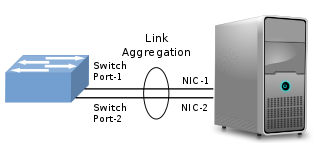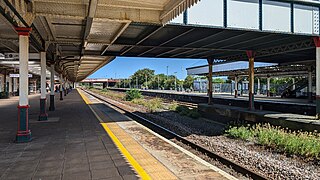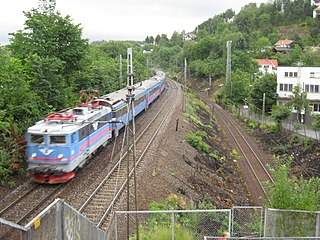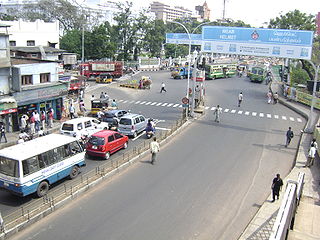Related Research Articles

A virtual local area network (VLAN) is any broadcast domain that is partitioned and isolated in a computer network at the data link layer. In this context, virtual refers to a physical object recreated and altered by additional logic, within the local area network. Basically, a VLAN behaves like a virtual switch or network link that can share the same physical structure with other VLANs while staying logically separate from them. Between network devices, VLANs work by applying tags to network frames and handling these tags in networking systems –creating the appearance and functionality of network traffic that is physically on a single network but acts as if it were split between separate networks. In this way, VLANs can keep network applications separate despite being connected to the same physical network, and without requiring multiple sets of cabling and networking devices to be deployed.

In Great Britain, there is a numbering scheme used to classify and identify all roads. Each road is given a single letter and a subsequent number. Though this scheme was introduced merely to simplify funding allocations, it soon became used on maps and as a method of navigation. There are two sub-schemes in use: one for motorways, and another for non-motorway roads.

The A57 is a major road in England. It runs east from Liverpool to Lincoln via Warrington, Salford and Manchester, and then through the Pennines over the Snake Pass (between the high moorlands of Bleaklow and Kinder Scout), around the Ladybower Reservoir, through Sheffield and past Worksop. Between Liverpool and Glossop, the road has largely been superseded by the M62, M602 and M67 motorways. Within Manchester a short stretch becomes the Mancunian Way, designated A57(M).
The freedoms of the air, also called five freedoms of air transport, are a set of commercial aviation rights granting a country's airlines the privilege to enter and land in another country's airspace. They were formulated as a result of disagreements over the extent of aviation liberalisation in the Convention on International Civil Aviation of 1944, known as the Chicago Convention. The United States had called for a standardized set of separate air rights to be negotiated between states, but most other countries were concerned that the size of the U.S. airlines would dominate air travel if there were not strict rules. The freedoms of the air are the fundamental building blocks of the international commercial aviation route network. The use of the terms "freedom" and "right" confers entitlement to operate international air services only within the scope of the multilateral and bilateral treaties that allow them.

Base station is – according to the International Telecommunication Union's (ITU) Radio Regulations (RR) – a "land station in the land mobile service."
In telecommunications, trunking is a technology for providing network access to multiple clients simultaneously by sharing a set of circuits, carriers, channels, or frequencies, instead of providing individual circuits or channels for each client. This is reminiscent to the structure of a tree with one trunk and many branches. Trunking in telecommunication originated in telegraphy, and later in telephone systems where a trunk line is a communications channel between telephone exchanges.

A cable modem termination system is a piece of equipment, typically located in a cable company's headend or hubsite, which is used to provide data services, such as cable Internet or Voice over IP, to cable subscribers. A CMTS provides many of the same functions provided by the DSLAM in a DSL system.

A trunked radio system is a two-way radio system that uses a control channel to automatically assign frequency channels to groups of user radios. In a traditional half-duplex land mobile radio system a group of users with mobile and portable two-way radios communicate over a single shared radio channel, with one user at a time talking. These systems typically have access to multiple channels, up to 40-60, so multiple groups in the same area can communicate simultaneously. In a conventional (non-trunked) system, channel selection is done manually; before use, the group must decide which channel to use, and manually switch all the radios to that channel. This is an inefficient use of scarce radio channel resources because the user group must have exclusive use of their channel regardless of how much or how little they are transmitting. There is also nothing to prevent multiple groups in the same area from choosing the same channel, causing conflicts and 'cross-talk'. A trunked radio system is an advanced alternative in which the channel selection process is done automatically, so as to avoid channel conflicts and maintain frequency efficiency across multiple talkgroups. This process is handed by what is essentially a central radio traffic controller, a function automatically handled by a computer system.

In computer networking, link aggregation is the combining of multiple network connections in parallel by any of several methods. Link aggregation increases total throughput beyond what a single connection could sustain, and provides redundancy where all but one of the physical links may fail without losing connectivity. A link aggregation group (LAG) is the combined collection of physical ports.

One-way traffic is traffic that moves in a single direction. A one-way street is a street either facilitating only one-way traffic, or designed to direct vehicles to move in one direction. One-way streets typically result in higher traffic flow as drivers may avoid encountering oncoming traffic or turns through oncoming traffic. Residents may dislike one-way streets due to the circuitous route required to get to a specific destination, and the potential for higher speeds adversely affecting pedestrian safety. Some studies even challenge the original motivation for one-way streets, in that the circuitous routes negate the claimed higher speeds.

The A453 road was formerly the main trunk road connecting the English cities of Nottingham and Birmingham. However, the middle section of this mainly single-carriageway road has largely been downgraded to B roads or unclassified roads following the construction of the parallel M42-A42 link around 1990. The M42 was originally meant to pass further north than it does, and to join the M1 at Sandiacre in Derbyshire. The M42/A42 does not enter Derbyshire, but instead joins the M1 closer to the A453 junction at Kegworth. The A42 shadows the former A453 from Appleby Magna to Castle Donington. The road historically connected the East Midlands with the West Midlands.

A collector road or distributor road is a low-to-moderate-capacity road which serves to move traffic from local streets to arterial roads. Unlike arterials, collector roads are designed to provide access to residential properties. Rarely, jurisdictions differentiate major and minor collector roads, the former being generally wider and busier.

Rhyl railway station is on the Crewe to Holyhead North Wales Coast Line and serves the holiday resort of Rhyl, Wales.
In telecommunications, cable Internet access, shortened to cable Internet, is a form of broadband internet access which uses the same infrastructure as cable television. Like digital subscriber line and fiber to the premises services, cable Internet access provides network edge connectivity from the Internet service provider to an end user. It is integrated into the cable television infrastructure analogously to DSL which uses the existing telephone network. Cable TV networks and telecommunications networks are the two predominant forms of residential Internet access. Recently, both have seen increased competition from fiber deployments, wireless, mobile networks and satellite internet access.

The A4232, which is also known either as the Peripheral Distributor Road (PDR) (Welsh: Ffordd Ddosbarthu Ymylol) or the Cardiff Link Road (Welsh: Ffordd Gyswllt Caerdydd), is a distributor road in Cardiff, the capital of Wales.
The Number Five Crossbar Switching System is a telephone switch for telephone exchanges designed by Bell Labs and manufactured by Western Electric starting in 1947. It was used in the Bell System principally as a Class 5 telephone switch in the public switched telephone network (PSTN) until the early 1990s, when it was replaced with electronic switching systems. Variants were used as combined Class 4 and Class 5 systems in rural areas, and as a TWX switch.
The Number One Crossbar Switching System (1XB), was the primary technology for urban telephone exchanges served by the Bell System in the mid-20th century. Its switch fabric used the electromechanical crossbar switch to implement the topology of the panel switching system of the 1920s. The first No. 1 Crossbar was installed in the PResident-2 central office at Troy Avenue in Brooklyn, New York which became operational in February 1938.

Multi-link trunking (MLT) is a link aggregation technology developed at Nortel in 1999. It allows grouping several physical Ethernet links into one logical Ethernet link to provide fault-tolerance and high-speed links between routers, switches, and servers.

The Loenga–Alnabru Line is a 7.3-kilometer (4.5 mi) freight-only railway line in Oslo, Norway. It runs from the classification yard at Loenga(Norway) to Alnabru Freight Terminal, typically serving twenty trains per day. It allows trains to pass from the Østfold Line to Alnabru without passing via Oslo Central Station. It is also used by freight trains from the Sørlandet Line, which run via the Oslo Tunnel and cross over at Bryn Station. It is notorious for the steep hill Brynsbakken which it has to climb, giving it a gradient of 2.6 percent.

EVR Periyar Salai (EVR High Road), earlier known as Poonamallee High Road(NH 48) and originally the Grand Western Trunk Road, is an arterial road in Chennai, India. It is the longest road in Chennai. Running from east to west, the 14-kilometre (8.7 mi) road starts at Muthuswamy Bridge near Madras Medical College at Park Town and ends near Maduravoyal Junction via Kilpauk, Aminjikarai, Anna Nagar Arch, Arumbakkam, Koyambedu. It further continues west towards Poonamallee and traverses the towns of Sriperumbudur, Walajapet, and Ranipet.
References
![]() This article incorporates public domain material from Federal Standard 1037C. General Services Administration. Archived from the original on 2022-01-22. (in support of MIL-STD-188).
This article incorporates public domain material from Federal Standard 1037C. General Services Administration. Archived from the original on 2022-01-22. (in support of MIL-STD-188).